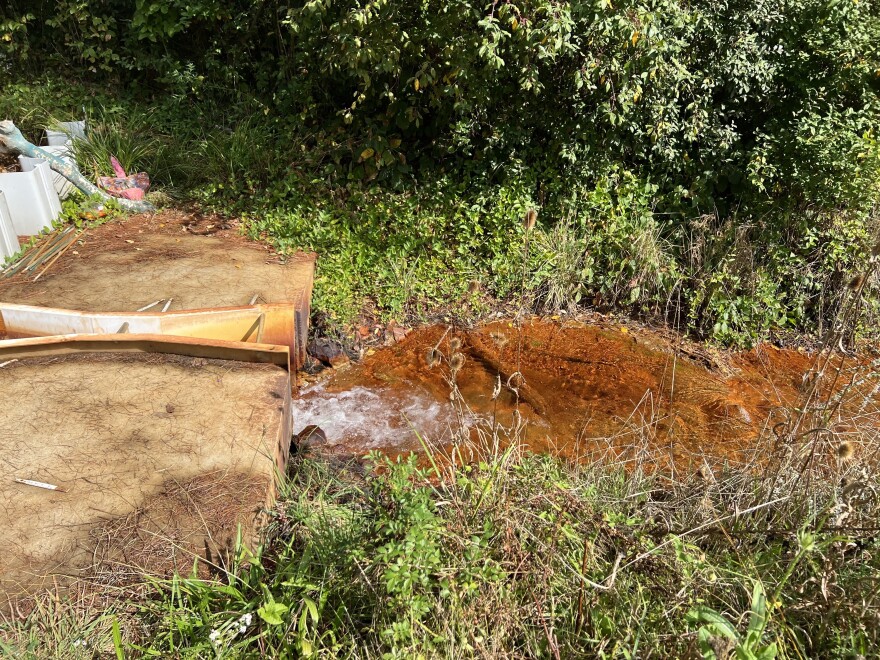The water running through Sunday Creek rambles without a hint of wildlife. There are no fish darting or crayfish to ensnare. Still, it catches the eye. The stream is a deep orange color.
Michelle Shively MacIver, of the local nonprofit Rural Action, pointed to the sludge-filled stream.
“This is all iron oxide,” said Shively MacIver. “So it's the same oxidation process as when you end up with rust. But here, it's happening in the water.”
Shively MacIver is a part of a group working to restore Sunday Creek, and waterways like it across southeastern Ohio. Up until the ‘60s, the area was actively mined. At that time, it was perfectly legal to seal up a coal mine and walk away.

These closed-down coal mines dot Appalachia. Though many of these mines were abandoned long ago, their impact remains: toxic sludge seeps out and pollutes Ohio’s streams.
“When those areas were abandoned, we end up with all this void space where water is going to find its way down in there,” Shively MacIver said. “And if you have water, oxygen, and pyrite … that starts a chain of chemical reactions.”
Those reactions lead to the chemicals, iron oxide and sulfuric acid, that make up the toxic orange sludge. So,two decades later, when the mine’s seal burst, it wasn’t just water that started pouring out. It empties out around 600 pounds of iron oxide, every single day.
An expensive problem
To Guy Riefler, a civil engineering professor at Ohio University, that’s intolerable.
“It's like junking several cars in that creek every day, since the 1980s,” Riefler said.
Reifler first saw one of these orange streams jutting through rural Ohio on a hike. He said he couldn’t believe no one had done anything about it. Not only did he find them ugly, he said it deprives the local community of its natural resources.
“It reduces your quality of life,” he said. “These are great little streams that would be good for fishing or kayaking … all of those things are unavailable to the local community because of this pollution.”

The problem is it’s expensive to treat this water. The materials needed to restore the water’s pH balance alone would be several hundred thousand dollars each year. But, the issue isn’t going away anytime soon. Reifler said the acid mine drainage will continue for at least another century.
“The question we were trying to ask was not how to clean it up, but how do we clean it up for free?” he said.
Creative solutions
He didn’t find his answer until he met John Sabraw, an art professor at Ohio University. They’ve spent the past decade working to take this acid mine drainage and turn it into a pigment.
They’ve discovered that the color that Reifler finds so ugly in the creek, can actually be pretty beautiful on a canvas.
Iron oxide is the same chemical used in rust-colored paints today. Riefler said once removed from the water, it can be dried up and ground into a pigment. Apply heat, and its natural ochre shade transforms into a vibrant red and a soft violet.
These paints are on full display at Sabraw’s art studio. Orange-brown hues swirl around other paints, bright blues and greens. Many of Sabraw’s abstract works recall natural formations, giving an aerial view of winding rivers and shores. Sometimes, he experiments with the pigments’ texture, allowing small cracks to form.
He said this new paint has completely changed his art. He shifted away from hyperrealistic oil paintings.
“It allowed me to enter a space where I can have an ongoing conversation with my environment, through paintings,” Sabraw said.
A ‘life’s dream’
More importantly, though, the pigments are making it possible to clean up the stream.
There’s quite a market for iron oxide. It’s in everything from paint, to ceramics, to concrete and brick to pharmaceuticals. Yet, most of the U.S.’s iron oxide is imported from abroad.
Shively MacIver, Reifler and Sabraw estimate they can sell the pigment for a dollar a pound. And with the sheer amount of iron oxide in the seven-mile stream, it should be enough money to sustain the costs of a water treatment facility.
“The whole point is to create a circular, sustainable process that pays for the cleanup of the streams by selling the pigment on the market,” Sabraw said.

So far, they’ve been doing this on a small scale to test its viability. But that’ll change soon. Thanks to funding from the Ohio Department of Natural Resources, the team broke ground this summer on a treatment facility big enough to completely rid the stream of its acid mine drainage.
Shively MacIver, through Rural Action, will oversee the TruePigments facility when it’s up and running. She said it’s exciting to think of all the art that could come from this effort, but she’s most excited to see bugs and fish return to Sunday Creek.
“We're doing it for the life, we’re doing it for the wildlife, to be able to bring the streams back to what they once were and what they should be,” Shively MacIver said.
The art is beautiful, she said. But the real beauty is in the clean, clear water itself.





